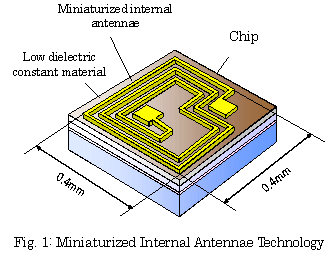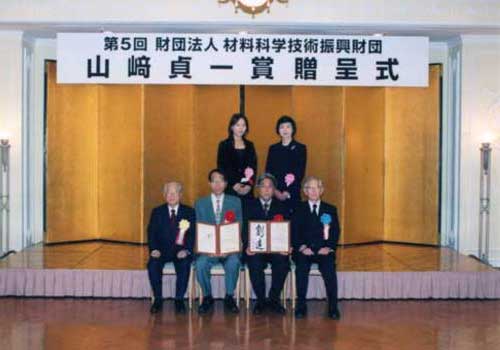The 5th (2005) Yamazaki-Teiichi Prize Winner Semiconductor & Semiconductor Device
Development of Ultra-Small Chip for IC Tags and Related Technology
| Winner | ||
|---|---|---|
| Mitsuo Usami | ||
| Affiliation at the time of the award | ||
| Senior Chief Researcher Hitachi, Ltd., Central Research Laboratory |
| Winner | ||
|---|---|---|
| Ryo Imura | ||
| Affiliation at the time of the award | ||
| Executive Managing Director Hitachi, Ltd. Mu-Solutions Division |
Reason for award
Mitsuo Usami and Ryo Imura succeeded with the development and practical application of the "¦Ì-chip": the world's smallest, microminiaturized IC tag chip. Because the conventional IC chips are fragile and easily broken, their range of application has been limited. However, the prizewinners discovered that silicon chips do not break easily when they are under 0.5mm square. By embedding this chip and items mounted with miniaturized antennas in various objects (including commodities, cards, foods, and medical products) and employing wireless, noncontact reading of data (IDs, product information, etc.,) items and information can be organically linked via network management so that anyone can obtain product information anytime, anywhere. In keeping, the prizewinners have succeeded in substantially expanding the application range for IC tags.
Their developments combine the following technology for an outstanding overall system concept using their original, miniaturized semiconductor chip: (1) technology for making miniaturized semiconductor chips (0.4mm square, 0.06mm thick), (2) ID reading technology using wire selection (at 128 bits, the equivalent of an IPv6 address, with a structure that makes falsification impossible), (3) the development of an microminiaturized antenna (of 1/3 the conventional ratio), (4) hardware technology consisting of low-cost mounting technology (with structures with electrodes on one side or both sides), (5) wireless communications protocol (making command control unnecessary), and (6) software technology consisting of ID management technology using the Internet.
Immediately after it was announced as a product, this IC chip had a major impact throughout the world, attracting attention for its broad application range. In addition to being applied to reservation and admissions systems for Expo 2005 Aichi Japan, its verification and testing are progressing domestically for international-distribution management systems for apparel ordering and production, management of food distribution, condominium security systems and the like.
Domestically, authorization has been acquired for use as the standard tag for Ubiquitous ID Center taking the lead in IC tag development. Adoption overseas has also begun, including for museum admissions-ticket systems in the US (San Jose), health-food traceability systems in Korea, systems for children's safe commuting in China, and numerical controlled machine-tool FA systems in northern Europe. Both prizewinners are diligently engaged in activities to facilitate international dissemination and have been invited to lecture by numerous international associations. At present, although about 10 companies overseas and about 10 in Japan are engaged in IC tag commercialization, Hitachi leads the market with mass production of the "¦Ì-chip."
Although their work consists of developments in the areas of both semiconductor-parts technology and systems technology, the originality or the core technology lies in the semiconductor chip miniaturization technology; in keeping, they have been awarded this prize.
Background of research and development
This development pertains to IC tag technology for noncontact ID reading with wireless technology using semiconductors. As IC tags are used for a multitude of purposes, including the prevention of counterfeiting of valuable paper and documents, such as paper money, and the support of ubiquitous society, there are exceptional demands for them to be microminiaturized, inexpensive and highly reliable.
¡¡The prizewinners succeeded in developing the "¦Ì-chip" ¡Ý the world's smallest (0.4mm square), microminiaturized IC tag chip ¡Ý and associated system technology. In doing so, they created an original business model to keep ubiquitous society in tow. The technology developed was for microminiaturized IC tag chips, external antennas and related mounting, miniaturized internal antennas, miniaturized readers and network systems.
Achievements
To secure the mechanical strength for embedding the chips in paper to prevent the counterfeiting of paper money and the like and to achieve high reliability, the prizewinners conducted impact testing and discovered that at sizes under 0.5mm square, mechanically fragile IC chips demonstrated outstanding improvements in strength. To make this improved mechanical strength compatible with a low price, they relied not only on process miniaturization but were thorough in achieving miniaturization under 0.5mm square. Investigating architecture to make the price low from its fundamentals, they implemented the following ideas:
(1) The conventional IC tags required memory to record variable information (historical information, etc.) and fixed information (the subject's ID, etc.) within the chip. By using Internet servers to provide memory for variable information, the prizewinners simplified the chip so that it only had read-only memory (ROM) to record fixed information through wire selection. This enabled the miniaturization of memory cells and did away with the need for writing circuits. (2) ROM also made the memory impossible to falsify.
(3) They made ROM capacity equivalent to the 128bits of IPv6, an Internet address format, succeeded in making the scale small, and adopted an almost limitless ID-identifying format using non-meta information codes (number combination code). (4) To prevent the duplication of IC-tag ROM IDs, they applied top-down management and made the IC tags network-based for traceability and supply chains.

As shown in Figure 1, the technology for miniaturized internal antennas using the world's smallest IC tag chip is the world's smallest (0.4mm square) antenna technology within a communication range of 1mm. Parasitic capacitance was lowered by adding a material with a low dielectric constant (polyimide) between the antenna and the chip, which in turn raised inductance, enabling a communication distance of 1mm to be attained. This has made it possible to prevent the counterfeiting of paper money, securities and other such instruments requiring the protection of privacy.
Meaning of the achievements
The IC tag is a device crucial to ubiquitous society for assigning a unique ID to every item and linking items and information via networks. The "¦Ì-chip," the world's smallest IC tag chip developed for this purpose, contains universal elements in its technology for system positioning, high reliability and economy. It is highly expected that this technology will both have a major societal impact and contribute substantially to IC tag development henceforth.

